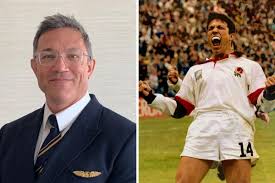Tony Underwood: The Flying Wing Who Soared Beyond Rugby

Early Life and Background
Tony Underwood was born on 17 February 1969 in Ipoh, Malaysia, before moving to England with his family at a young age. His upbringing in a multicultural environment helped shape his open-minded approach to both life and sport. Growing up, he was deeply influenced by his elder brother, Rory Underwood, who would go on to become one of England’s greatest rugby wingers. Inspired by his brother’s achievements, Tony developed a passion for rugby from an early age, blending athleticism, discipline, and intelligence into his game.
The Underwood brothers shared a strong sporting bond, yet Tony was determined to carve out his own identity in rugby. His natural pace, quick reflexes, and sharp instincts made him a standout at school level, leading him to represent Cambridge University in rugby before stepping onto the professional stage.
Rugby Career Beginnings
Tony Underwood’s rise to prominence began during his time at Cambridge, where he played in the prestigious Varsity Matches against Oxford University. His performances quickly caught the attention of selectors and clubs alike. Soon after, he joined the Leicester Tigers — a powerhouse of English rugby — where his electric speed and try-scoring ability made him a crowd favourite.
Playing for Leicester helped Tony develop his skills at an elite level. Competing alongside and against some of the best players in the country sharpened his tactical understanding of the game. His consistency and explosive style of play soon earned him national recognition and a call-up to represent England.
International Debut and Achievements
Tony Underwood made his England debut in October 1992 against Canada. From that moment, it was clear that a new star had arrived. He brought flair and unpredictability to England’s backline, adding a new dimension to the team’s attack. His ability to finish scoring opportunities made him a vital part of England’s wing combination throughout the early to mid-1990s.
During his international career, Underwood earned 27 caps for England and scored 65 points, a remarkable feat that highlighted his effectiveness as a winger. One of his defining moments came in the 1995 Rugby World Cup, where he represented England on the global stage. Despite facing some of the toughest opponents in world rugby, Tony’s speed and creativity left a lasting impression.
Playing alongside his brother Rory for England created one of the most memorable partnerships in rugby history. The Underwood brothers were the first sibling pair to play together for England since World War II, capturing the imagination of fans across the nation. Their combination of experience and youthful energy symbolised England’s rugby renaissance during the 1990s.
Playing Style and Strengths
Tony Underwood was renowned for his blistering pace, sharp agility, and instinctive try-scoring sense. His acceleration off the mark often left defenders trailing behind, while his low centre of gravity made him difficult to tackle. Unlike many wingers of his time who relied solely on brute strength, Underwood combined finesse with tactical awareness, often exploiting gaps and reading the game several steps ahead.
His attacking prowess was complemented by a strong work ethic and defensive commitment. Coaches often praised his discipline and ability to adapt to different match situations. Tony wasn’t just fast — he was intelligent, strategic, and composed under pressure.
Club Career Success
Outside the international scene, Tony Underwood enjoyed success with both Leicester Tigers and Newcastle Falcons. His time with Leicester was defined by consistency and teamwork, while his move to Newcastle later in his career offered a fresh challenge and an opportunity to contribute to a rising club.
At Newcastle, Underwood brought experience and leadership to a younger squad. He played a key role in helping the team establish itself as a competitive force in English rugby. His influence extended beyond his playing ability — he was admired for his professionalism, humility, and mentorship of emerging players.
1995 Rugby World Cup: A Defining Chapter
The 1995 Rugby World Cup held in South Africa was a significant turning point in Tony Underwood’s career. England reached the semi-finals, showcasing determination and resilience. However, it was also the tournament that tested Tony like never before, particularly when facing the legendary Jonah Lomu of New Zealand.
Despite England’s defeat, Tony handled the experience with dignity and self-reflection. Rather than allowing that match to define him negatively, he used it as motivation for personal growth. The encounter with Lomu became a moment of learning — a lesson in the power of perseverance and humility in sport.
Underwood’s response to that challenge won him the respect of fans and fellow players alike. He demonstrated that true sportsmanship lies not only in victory but also in how one faces adversity.
Life After Rugby
After retiring from professional rugby, Tony Underwood embarked on an entirely new adventure — aviation. Transitioning from the rugby field to the cockpit, he trained as a commercial pilot and went on to fly for major airlines, including Virgin Atlantic.
This career shift was not only impressive but also deeply symbolic of his character. The same discipline, focus, and calmness that made him a successful rugby player translated seamlessly into his aviation career. Flying aircraft thousands of feet above the ground became an extension of his lifelong pursuit of excellence.
Tony’s post-rugby life reflects his ability to reinvent himself while staying true to his core values — dedication, hard work, and ambition. His journey is a powerful reminder that professional athletes can thrive beyond their sporting careers when they apply their skills and determination to new challenges.
Personal Life and Character
Away from the public eye, Tony Underwood is known for his modesty and grounded nature. Despite his achievements, he has always maintained a low profile, focusing on his family and personal growth. Those who know him describe him as intelligent, articulate, and deeply reflective.
He has occasionally shared insights about mental resilience, teamwork, and adapting to life after sport, providing inspiration for young athletes. His balanced outlook and determination to excel in both sport and aviation highlight the versatility of his character.
Legacy and Impact
Tony Underwood’s legacy extends far beyond the tries he scored or the matches he played. He represents a generation of rugby players who combined education, professionalism, and athletic excellence. His ability to balance academic achievement at Cambridge with a successful rugby and aviation career sets a remarkable example for aspiring sportsmen.
Moreover, Tony’s story is one of transformation — proof that greatness is not confined to a single field. He remains a respected figure in British rugby history, admired for his humility, courage, and adaptability.
Today, Tony Underwood continues to inspire both sports fans and professionals across industries. His life demonstrates that success is not just about where you start or what you achieve, but how you evolve and continue to push boundaries.
Conclusion
Tony Underwood’s journey is one of rare inspiration — a tale of speed, skill, and soaring ambition. From the green pitches of England to the open skies above, he has lived a life that embodies excellence and resilience.
As a rugby player, he thrilled crowds with his pace and precision. As a pilot, he commands respect for his focus and professionalism. And as a person, he stands as a testament to what can be achieved through passion, hard work, and adaptability.
Tony Underwood remains an enduring symbol of determination — a man who didn’t just chase dreams but flew high enough to reach them.



